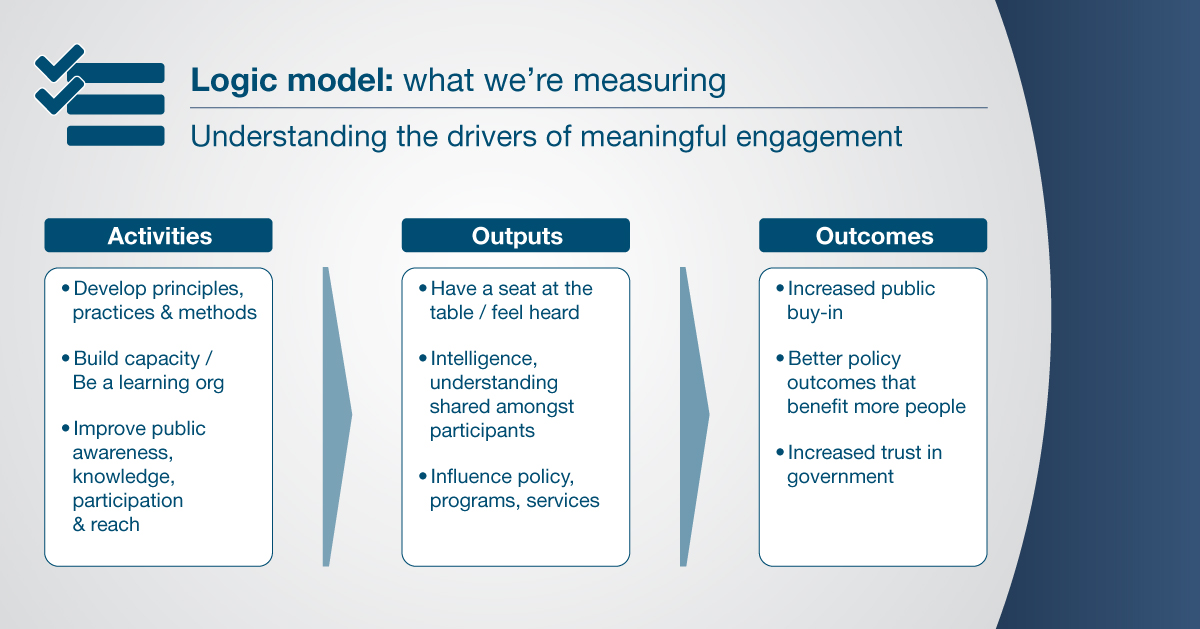Recently we published public engagement principles for the Government of Canada. This was part of our Open Government commitment to Enable Open Dialogue and Open Policy Making. We were delighted by how many people helped us along the way, which Thom has written about. This post explains what we intend to do with these principles, and how it helps us move towards a more participatory approach to governance.
Baseline indicators
Our hypothesis is that increased engagement will lead to increased trust in government. We have baselined the following indicators:
- Awareness in the opportunities to participate (37% in 2017)
- People feel they are provided with opportunities to participate (8% in 2007, 10% in 2017)
- Participation rates in government-led consultations (22% in 2007, 34% in 2017)
- Satisfaction with consultations, for those who have participated (18% in 2007, 37% in 2017)
- Government cares about the concerns of Canadians (30% in 2007, 36% in 2017)
- Trust in government to do what is right (27% in 2007, 41% say almost always in 2017)
What are the steps between engagement and trust?
According to the Rethinking Citizen Engagement research study, the first step in meaningful engagement is that people feel they had information needed to meaningfully participate. They also report that they are more likely to participate if their feedback helps shape decisions. They agree that government should consult broadly to get a range of views.
Based on the data collected in the research study, we have outlined the process of meaningful participation as such:
- People are aware of opportunities to participate.
- People have information needed to contribute.
- People feel their input was heard.
- People think their input will be used to shape government decisions.
- People learn about others' views and have an opportunity to discuss trade-offs.
- Better policy results from developing options with a broader range of people.
- People's trust increases as they see a government that reflects the people it serves.
The first draft of our logic model, therefore, looks like this:

Logic model - Text version
Logic model: what we're measuring
Understanding the drivers of meaningful engagement
Activities
- Develop principles, practices, and methods
- Build capacity / Be a learning organization
- Improve public awareness, knowledge, participation, and reach
Outputs
- Have a seat at the table / feel heard
- Intelligence, understanding shared amongst participants
- Influence policy, programs, services
Outcomes
- Increased public buy-in
- Better policy outcomes that benefit more people
- Increased trust in government
This framework helps us measure ourselves against these baselines as we try to improve.
We would love to hear your thoughts. Are we measuring the right things? Does the logic model make sense? Post your comments here or help us develop our measurement framework on GCcollab.

Laura Wesley
Executive Director, Consultations and Public Engagement, Privy Council Office, Government of Canada
Laura has a track record of disrupting the status quo to bring about results. Her knowledge of, and interest in, systems change, service design, and human motivation form a lens through which to consider new ways of working together. After more than a decade working in the federal public service, she's come to believe that working across boundaries – sectors, disciplines and organizations – results in better outcomes for everyone. In guiding individuals and teams, Laura shows an unwavering commitment to supporting people through change.







